GUEST BLOGGER CYNTHIA ARGENTINE
In a fascinating study, scientists discovered that “nature connectedness” helps people feel life is worthwhile. Those who felt more connected to nature also felt happier and healthier.[i] Wonderful! But before we drop everything and head outdoors, consider this: Simply being outside isn’t enough. We have to pay attention to nature. People with “nature connectedness” notice things. They engage their senses.
The great news is that noticing nature doesn’t have to mean spending a week camping deep in a national forest—as awesome as that might be. A backyard garden or local trail can work just as well. The key is to tune in, to notice details.
Pay attention to nature with a mentor text
Sheri M. Bestor’s book WHEN YOU GO INTO NATURE (Sleeping Bear Press, 2024) demonstrates the art of noticing. The opening lines use fanciful language to set the stage: “When you go into nature… you’ll learn to move slowly—like snails who leave trails of glimmering glinter. And blossoms that bloom at the end of the winter.” The book continues by connecting things a child might casually observe, such as geese flying south, to larger ideas, such as teamwork.
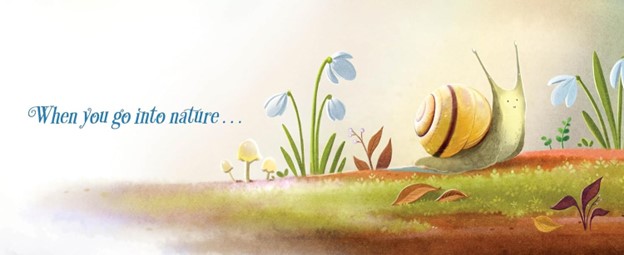
Here’s another spread: “You’ll learn about strength… from the web of a spider attached to the trees, and the birch and the maple and pines in the breeze.” The author also highlights patience, softness, expression, and letting go, giving examples of each in nature.
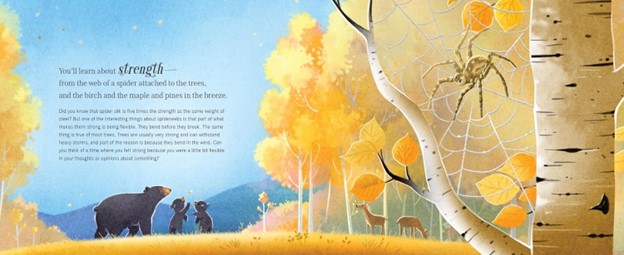
Try these four activities to help the kids in your life pay attention to nature.
1: Create a classroom “Noticing” book or bulletin board (K-3)
- Go outside to a natural area with students. Guide them to notice things. What do they see? hear? smell? feel? Even in a small area, you can hopefully observe plants, rocks, insects, birds, and clouds.
- Ask each student to notice something new or something that surprises them about something familiar. Ask each one to draw or paint the particular thing they noticed. Older students may also write a phrase or sentence about it. For example, “I noticed clouds. They move fast.” Or, “I noticed a dandelion puff. Its seeds were so light I could barely feel them.”
- Compile the pages into a classroom “noticing book” or make a bulletin board display.
2: Rhyming read-aloud and group discussion (grades K-2)
- Read the large-font sections of WHEN YOU GO INTO NATURE aloud, skipping over the sections in the smaller font.
- After reading each page, ask children what they notice about the sounds of the words. Which words rhyme (e.g., trees and breeze)? Are there repeated sounds (e.g., blossoms that bloom)? Does the sound of the words create a mood or feeling (such as peaceful, exciting, or happy)?
- With each page spread, point to the items in the pictures (e.g., snail trails, hatchlings). Allow students a few moments for “elbow partner” discussions where they can share whether they have ever seen those items in real life.
3: Connecting STEM facts to life skills (grades 2-3)
- If you have not already done so, read aloud WHEN YOU GO INTO NATURE, skipping the smaller font sections.
- Ask a volunteer to say which page-spread was their favorite. Go back to that page and read the text in the smaller font. These passages make additional STEM connections. Here’s an example from the page about strength:
“Did you know that spider silk is five times the strength as the same weight of steel? But one of the interesting things about spiderwebs is that part of what makes them strong is being flexible.…”
From WHEN YOU GO INTO NATURE by Shari M. Bestor, illustrated by Sydney Hanson (Sleeping Bear Press, 2024)
- Ask students how they could use the highlighted qualities (here, strength and flexibility) in their own lives.
- Continue with additional pages as time allows.
4: Focus on contrasting writing styles (K-3)
- Ask students to compare and contrast the two different sections on each page. Do they look different? Sound different? Feel different? How so?
- Conduct a quick survey. How many students prefer the rhyming poetry (the larger font)? How many prefer the more detailed and fact-rich sentences (the smaller font)?
- Explain that both ways of writing are valuable and useful.
May observing nature, noticing thoughtful language, and contemplating the natural world bring joy to our students and readers.
Featured image credit: “Photo of the Week – Connecting Children with Nature” by U. S. Fish and Wildlife Service – Northeast Region is marked with Public Domain Mark 1.0.
Cynthia Argentine loves to notice nature—particularly while hiking and kayaking. Her goal is to fuel kids’ creativity and imagination with insightful and inspiring books. Her book Night Becomes Day: Changes in Nature (Millbrook Press) was a Bank Street “Best Book of the Year” and a finalist for SCBWI’s Golden Kite Award. A forthcoming book celebrates an amazing NASA pioneer. Other titles cover cybersecurity, Latin music, and more!
She loves to connect with readers—
- Website and Blog “Cup of Tea with Cindy”: https://cynthiaargentine.com
- X (Twitter): @CindyArgentine
- Pinterest: @CynthiaArgentine
- Instagram: @argentine_writer
[i] Noticing Nature. National Trust (UK) and University of Derby. 2020.


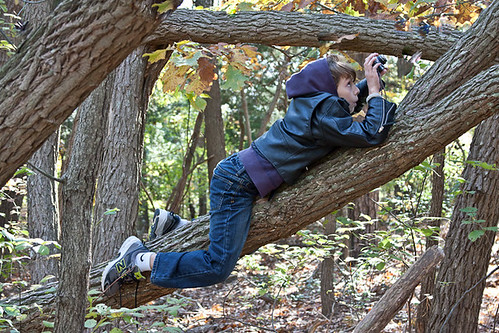

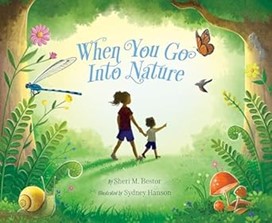

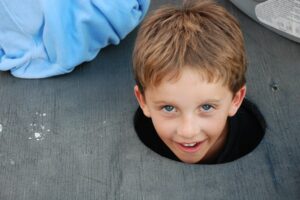

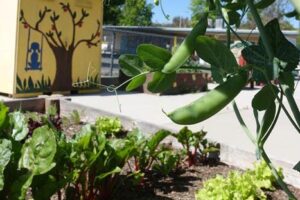


Leave a Reply
Your email is safe with me.